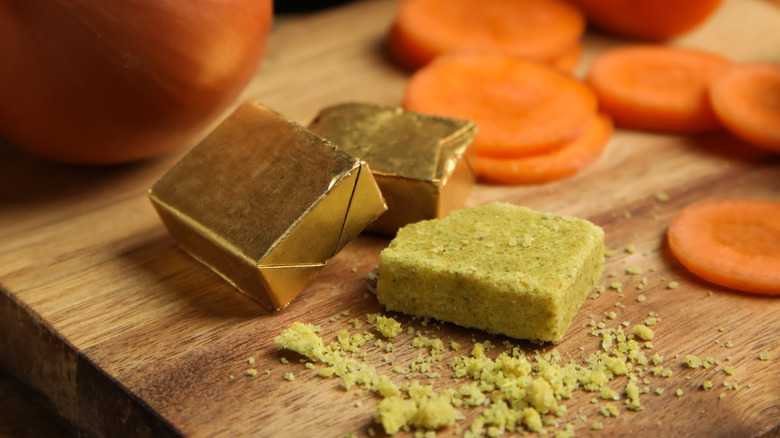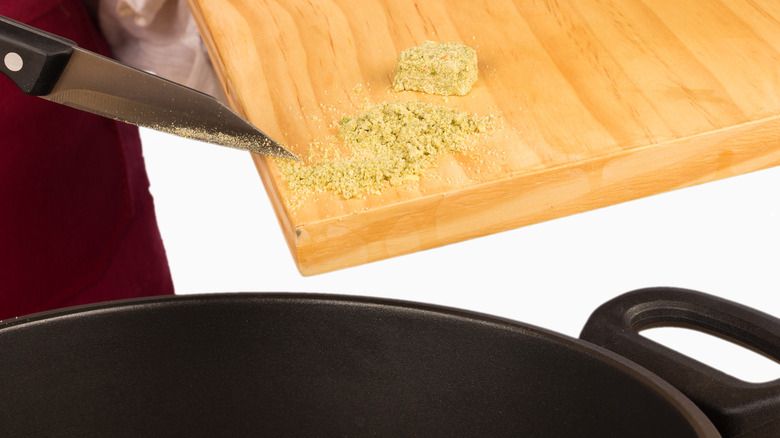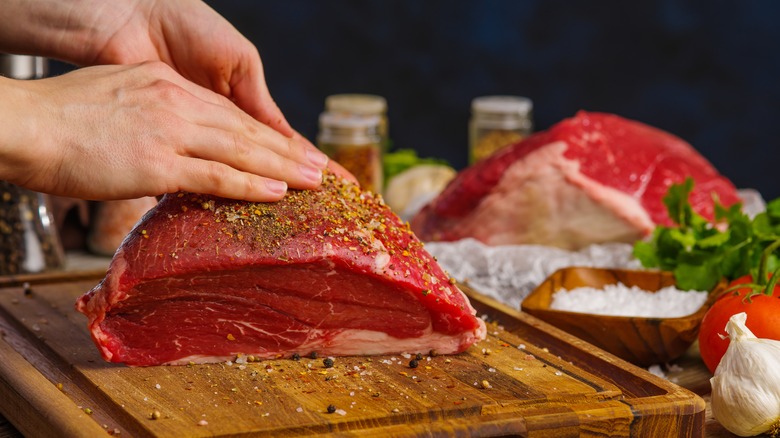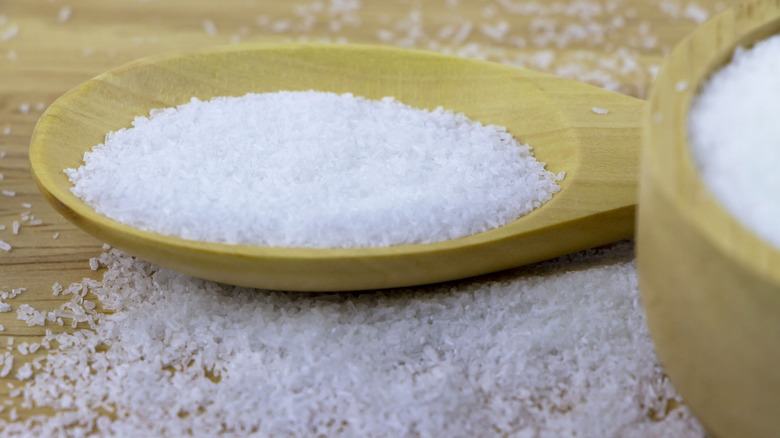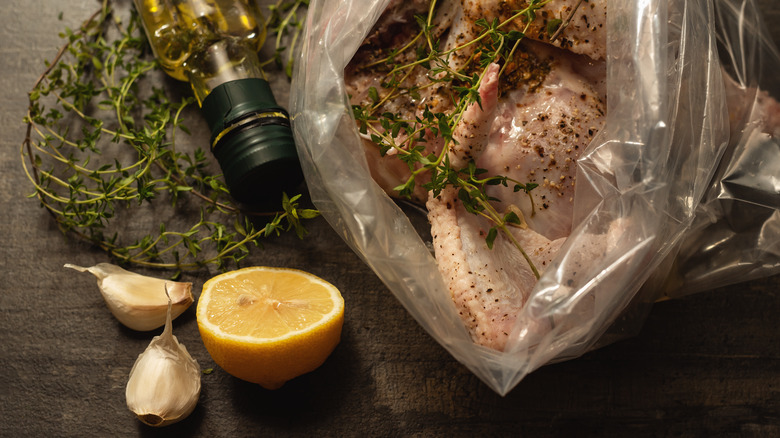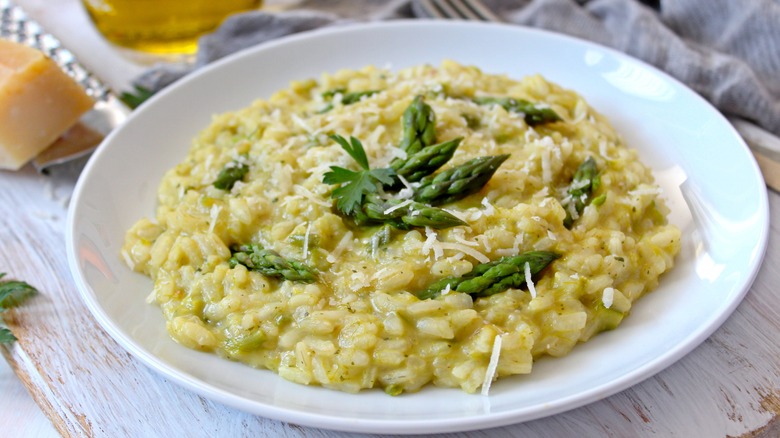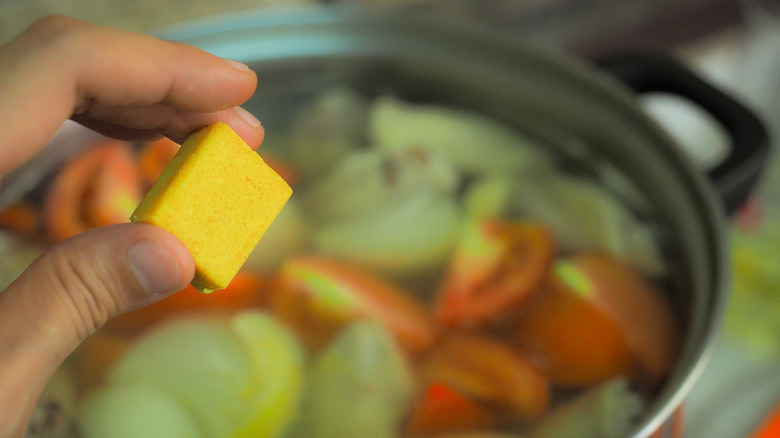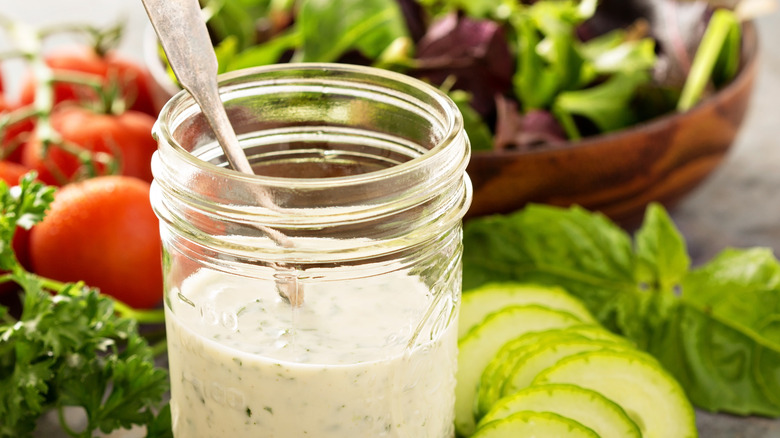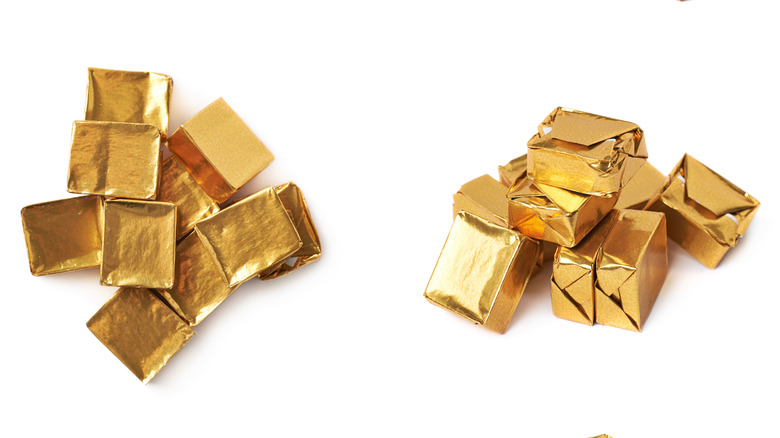11 Tips You Need When Cooking With Bouillon Cubes
Are they little blocks of flavor, big bombs of salt, or just your basic kitchen hack? The answer to that question is simple: yes. Bouillon cubes are all of that. The commercial origins of bouillon go back to the Swiss Maggi corporation's introduction of a product in 1907. But the true history of bouillon cubes themselves is much older than that. In 1803, Merriweather Lewis (as in "Lewis and Clark") carried what he called "portable soup" — an "ancestor of the modern bouillon cube" — on the famed landmark expedition, per Discover Lewis & Clark. But it was humanity's shared love of broth that led to the popularity of the now-ubiquitous bouillon cube.
To understand the bouillon cube and its popularity, it helps to know the difference between stock, broth, and bouillon. The critical difference between stock and broth is that while both are tasty liquids made from ingredients, including vegetables, stock uses bones, whereas broth uses meat (but not bones). This results in important differences in the texture and flavor of the liquids and how they can be used.
So, what is a bouillon? It is, essentially, broth dehydrated into a powder. It can come either in powdered form or condensed and compressed into a cube. Different bouillon manufacturers generally add additional ingredients to the powder, including salt and MSG.
Know your cubes and dilution ratios
Because bouillon powder — whether in the form of a cube or not — is dehydrated broth, using it for the liquid in your soup, sauce, stew, or even to sip by the fire requires rehydrating that powder. But how much water should you use for each bouillon cube? Use too much water, and your likely result is a thin and not particularly flavorful liquid. Use too little water, and you will have a salt bomb on your hands.
As a result, one critical factor in successfully using bouillon cubes is knowing the correct dilution ratio for your bouillon cubes: how much water to use to properly rehydrate your bouillon cube or cubes into a broth. Conventional wisdom, and the internet, tend to put that at 1 cup of water per bouillon cube.
But, there are multiple different brands of bouillon cubes. While the 1 cup to 1 cube ratio will work for many brands (Wyler's or McCormick, for example), it would result in doubly concentrated broth for two of the most popular brands: Knorr and Maggi. For those brands, the ratio is 1 cube to 2 cups of water. The answer to this problem is simple: read the label to know the proper dilution ratio.
Boost your stock with bouillon cubes
Making a stock recipe can be a very grounding experience. Brown some bones and add them along with chopped onions, carrots, and celery to a big pot, a dollop of tomato paste, and some herbs. Bring it all to a simmer, occasionally skimming for at least six hours for chicken stock and up to eight hours for beef bones. The method of flavor extraction from the bones through the long cooking process characterizes stock.
So, yes, stock-making can be a rewarding endeavor and not a particularly difficult one. But it is, inarguably, a time-consuming enterprise. You would not do it every day unless you're a chef or have time on your hands.
This is where bouillon cubes can come in handy. The Barefoot Contessa, Ina Garten, adds bouillon cubes to boost the flavor of the chicken stock before making a chicken pot pie. But why not do much the same with the stock itself? Instead of simmering the stock for six to eight hours, cut that time a bit shorter and add in a few bouillon cubes. What you might lose in the body of the stock you more than makeup for in the intensity of flavor those little cubes of dehydrated brothy goodness bring to the party.
Think of bouillon cubes as a spice rub or seasoning
Sure, bouillon cubes are great for turning water into a broth, but they shine when you realize they are an intensely concentrated cube of flavor available wherever a flavor boost is needed. Just because that bouillon comes in the form of a cube does not mean you can't use it as a powder.
Perhaps the simplest and most direct way to do so is to grate the bouillon cube itself and sprinkle the resulting powder over the meat of your choice as a seasoning salt or spice rub before cooking. Or you could use the grated bouillon cube as a straight-up salt replacement for roasted vegetables. As Food Network Canada points out, some chefs see the benefit of scattering the stuff over foods to give them an extra kick of umami.
But grating bouillon cubes can also be a first step in creating your own umami-driven seasonings. For example, former Top Chef contestant Kwame Onwuachi uses ground bouillon cubes for the Suya spice blend in his Nigerian mixed grill recipe. Or, add some pepper with a grated beef bouillon cube, and you'll have the makings of a perfectly seasoned steak. You could toss a chicken breast with a cumin-spiked grated tomato bouillon cube for some distinctly Tex-Mex flair. Grind some Italian seasoning, add some grated chicken bouillon, and have a perfect seasoning to go along with the flour for this crispy veal parmesan recipe.
Beware the saltshaker
The mere fact bouillon cubes can be used as a substitute for, or even an improvement on, salt highlights the reality that they are little sodium bombs. Cravings in Amsterdam observes that a single bouillon cube can contain up to 1,000 milligrams of sodium, and a Wyler's chicken bouillon cube, for example, contains 800 milligrams of sodium. To put that in perspective, the Centers for Disease Control and Prevention's dietary guidelines for Americans recommend an intake of fewer than 2,300 milligrams of sodium per day. In other words, one bouillon cube can be over ⅓ of an individual's total recommended daily salt intake!
The good news is that there are now lower sodium bouillon cube alternatives. For example, Edward & Sons makes a plant-based "Not-Chick'n" product with only 120 milligrams per serving, Herb-Ox also has a sodium-free version, and Knorr has introduced both reduced sodium and "Zero Salts" chicken bouillon cubes. Sadly, neither of those products is widely available in the United States, though Knorr does offer the Zero Salt chicken bouillon in powdered form.
The ultimate solution is to be aware of the salt content of the specific bouillon cubes you are using within the context of what you are cooking. Use them as an ingredient in a side dish, for example, to flavor mashed potatoes or as part of a sauce. Be aware of the sodium level and adjust your recipes accordingly.
Embrace the umami
Some of the sodium in bouillon products, whether cube or otherwise, comes not from table salt but rather from those three wrongfully dreaded and widely defamed letters: MSG. But monosodium glutamate is not, contrary to popular belief, evil. Indeed, the seasoning makes things taste better, and there are many ways to use MSG because it is essentially powdered umami.
That, not to put too fine a point on it, is a very good thing. Umami is delectable. Lots of your favorite foods already contain MSG. Indeed, per Ajinomoto, umami in Japanese means the "essence of deliciousness." It makes everything it touches taste more intensely like itself. As Nobuyuki Matsuhisa, the celebrity Chef creator of the Nobu empire of restaurants puts it (per Shun Gate): "Umami is vital for creating delicious food."
One particularly intriguing way of using bouillon to embrace the umami is to mix different types of bouillon. For example, mixing vegetable bouillon (which contributes guanylate) with chicken bouillon (which brings inosinate to the party) results in a profound umami effect that is seven to eight times as intense as is either alone, per the Umami Information Center. Another, possibly unexpected, benefit of combining the two different types of bouillon cubes (read: sources of umami) and the resulting synergistic effect is that it allows you to achieve the same result using less sodium.
Use bouillon cubes in a marinade
When you think about bouillon cubes, it is generally in the context of creating some variety of tasty liquid. Of course, bouillon was created as a shortcut to, or method of preserving, broth or soup. So, those uses — or even a stew — are not much of a stretch.
One that does not come immediately to mind, though, might be one of the best options out there: a marinade. Knorr, one of the major bouillon cube manufacturers, recommends combining its tomato bouillon along with herbs, wine or vinegar, and olive oil in a tasty marinade for chicken. Or use ground chicken bouillon cubes with lemon, garlic, and oregano for a simple, elegant marinade. Add some of Knorr's chipotle cube to that marinade for a spiced flair.
If one of the downsides of bouillon is its high sodium content, ironically, that saltiness makes bouillon cubes a valuable ingredient in marinades. Again, grinding it into powder is one key to using bouillon cubes as a featured marinade ingredient. Once ground, that powder can be swapped as a one-for-one substitute for the salt in a marinade recipe. For example, whisk together extra-virgin olive oil, an acid, a ground chicken bouillon cube, and pepper with some garlic and Mediterranean herbs (like rosemary and thyme) and give your bone-in, skin-on chicken thighs recipe a start by bathing in a marinade before giving a good broil.
Make a sauce or compound butter
It is easy and tempting for the snobby amongst us to think of bouillon cubes as something of a cheat. That little devil on our left shoulder seems to whisper in our ear: "no real chef would do something like that." Well, tell that to legendary Chef Marco Pierre White who has been known to make a paste with bouillon cubes and olive oil to season and enhance the caramelization of steak. Pierre White once told the Guardian that a certain brand of bouillon cubes was "one of the greatest inventions in gastronomy ..." perhaps stemming from the fact he had a Knorr endorsement contract, though he professes (per BusinessLive) to use the products at home as well as professionally.
You could do the same as Chef White but finish the steak with a bouillon cube compound butter. Or make a red wine reduction sauce, a derivative of a classic French mother sauce, but replace the beef broth with beef bouillon (made using the proper dilution ratio as discussed above) and some corn starch. While this might sound at first blush like the type of cheat that no restaurant would use, the reality is different. Bouillon cubes are similar to the types of browning agents and base ingredients that nearly every restaurant keeps (shy of the Michelin level) in the pantry.
Use bouillon cubes as a cooking liquid
One way of using bouillon cubes that might seem slightly less intuitive comes from the world of pasta. The name for spaghetti all'ubriaco, also known as drunken spaghetti, comes from the fact that instead of sauce, red wine features both as a star ingredient and as the cooking liquid for the spaghetti. Why not use a different liquid — broth from bouillon cubes — in much the same way?
Just as the spaghetti takes on the color of the wine, it also takes on the flavor of the liquid it cooks in. That is why most traditional pasta recipes have you salting the water instead of cooking in unseasoned liquid. The seasoning makes it taste good, and the bouillon cube does a fantastic job of seasoning the water and, thus, the cooked pasta.
Bouillon cubes can be used for the broth to make a risotto, infusing each grain of the rice with the rich umami flavor from the cube. Try it in huitlacoche and black garlic risotto, one of the best ways to use MSG because you're tripling down on the umami. Bouillon may be the ultimate simple trick to make rice delicious. Or use it in an Amish-style chicken and noodles recipe. Almost any grain — quinoa, couscous, potatoes, grits, masa, and many more — will taste better cooked in broth than straight water.
Don't forget the intended uses
Bouillon cubes have come a long way since being Lewis and Clark's "portable soup." But they have not come so far that there is any more appropriate use for them than that most obvious of uses: soup. Since bouillon cubes are, at base, a shortcut for stock or broth, they can be used wherever a recipe calls for either of them. However, make sure to remember to account for the higher salt content of bouillon.
Take, for example, a creamy potato leek soup recipe in which bouillon cubes are an essential component. You could also go with a classic chicken noodle soup. Pork or vegetable bouillon cubes are all also usable to go along well with the water for a great pork pozole recipe. Exchanging beef bouillon for beef broth in birria tacos is natural.
Even if you are not going to swap water and bouillon cubes for stock in your soup or stew, that does not mean those bouillon cubes can't come in handy. Sometimes soup or stew lacks the intensity you're striving for. That's when bouillon cubes can come to the rescue. Just pop in half a bouillon cube and see if that does the trick. As we've already seen, that's what Ina Garten does to boost the flavor of her chicken stock.
Use bouillon cubes in salad dressings
Perhaps one of the least intuitive uses of bouillon cubes is as a feature ingredient in salad dressings. We suggest using cubes instead of salt to season Italian-style vinaigrettes. There is no reason why that wouldn't work. Just take part of a bouillon cube and chuck it, along with lemon juice or vinegar, oil, mustard (and some herbs if desired), into a high-speed blender or food processor, and you've got a salad dressing.
Do you want a hint of sweetness in your dressing? Add some honey or maple syrup, and use apple cider vinegar. If you want some of the nuances that fermentation provides, augment your dressing with the layered complexity of white miso. For an added unctuous depth, toss in eggs, an anchovy or two, and a dash of Worcestershire sauce to take things in a Caesar-like direction.
But for our money, the choice would be simple: ranch dressing. There is just something about the tang and creaminess of this bona fide American salad dressing classic. Indeed, the flavor profile of bouillon cubes captures so much of what is there in the original that it feels natural if not an original. Just substitute the grated bouillon cube for the MSG and the garlic and onion powders, and you do not just have a variation but perhaps an improvement.
Don't sleep on the wide range of flavors
Once upon a time, the choice of flavors for bouillon cubes was limited. The original Maggi product was a meat extract, probably beef (per Serious Eats) though the specifics are lost in time. Beef, chicken, and vegetable bouillon cubes are widely available in the United States. Four companies have historically dominated the market: Maggi, Knorr, OXO, Wyler's, and until recently, McCormick (which has discontinued a number of its bouillons).
That was then; this is now. More recently, the types of bouillon cubes available in the market have expanded greatly. OXO now sells a lamb stock cube product. Edward & Sons offers a full line of vegan products. Look a bit further, and you'll find that Knorr offers shrimp cubes, tomato with chicken, and a line of cubes that include ham and seasonings like cilantro and achiote, garlic, onion, chipotle, and more. Around the world, Knorr sells different products (many of which are available online), including porcini mushroom cubes.
Each of these new flavors of bouillon cubes offers another world of recipe possibilities using many of the approaches described above. Imagine, for example, using those porcini mushrooms or achiote bouillon cubes to grind into a spice rub or as part of a marinade for chicken breasts. Or take the ham along with the cilantro cubes as the base compound butter. Nearly any of those products would shine as a cooking liquid for rice.
